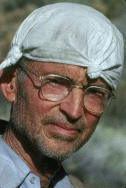Harvey Butchart facts for kids
John Harvey Butchart (born May 10, 1907 – died May 29, 2002) was a mathematics professor. He became very well known for his incredible hiking adventures. These adventures took place in and around the Grand Canyon in Arizona, United States. Starting in 1945, Butchart explored the Grand Canyon's wild areas on foot. He wrote many detailed notes about his trips. His writings inspired many generations of canyon explorers.
People have lived and traveled in the Grand Canyon for a very long time. Ancestral Puebloans were among the first. Native Americans lived there when American explorers first arrived in the mid-1800s. Later, prospectors, miners, and researchers came. Today, many tourists visit. Most of the millions of visitors to Grand Canyon National Park stay in the developed areas. These are the South and North Rims. A smaller number hike into the Canyon on well-kept trails. A very tiny group goes even further. They explore the true wilderness of the Park. Harvey Butchart led the way for these adventurers. He used amazing physical strength and skill to go where few others could.
When Harvey Butchart moved to Flagstaff in 1945, he began exploring the Grand Canyon. After hiking the main trails, he started looking for unofficial routes. He used old Native American paths and even animal trails. He learned from experienced hikers like Merrel Clubb and Emery Kolb. Sometimes he hiked alone. But most often, he explored with friends and students. This group of hiking fans still exists today. They often connect through the Backcountry Information Center. A book written in 2007 tells his story. It also shares the history of foot exploration in the Grand Canyon.
Harvey Butchart's Grand Canyon Adventures
Unlike explorers before him, Butchart kept very detailed notes. His logs of explorations grew to more than 1,000 pages. He recorded 1,024 days spent inside the Canyon. He walked over 12,000 miles (19,000 km)! He climbed 83 peaks within the Canyon. He also scaled the walls at 164 different spots. He was the first to climb 25 of these places. People say he discovered over 100 routes from the rim down to the river.
By 1963, Butchart was known as the top expert on backcountry hiking. He made many trips over several years. He completed the very first route from one end of the national park to the other. Only about four miles near Great Thumb and Tahuta Points were left. Colin Fletcher was another famous hiker. He relied a lot on Butchart's knowledge. This helped Fletcher plan his own hike through the whole park in one journey. Fletcher once wrote that Butchart was like two people. One taught math, and the other lived in the Grand Canyon. Butchart's young grandson even asked, "Where Grandpa lives?" when he heard the words "Grand Canyon."
Starting in 1970, Butchart published three small books. These books contained his trail notes from his exploration records. He continued hiking until 1987. In 1998, his books were put together into one larger book. This new book also had extra material. Butchart's texts were known for being a bit hard to understand. They were written for people who were already strong and skilled hikers. These hikers needed to explore the most remote areas safely. His notes mainly focused on how to get past the big cliffs. They also showed where to find water sources. For many of these routes, his books are the only guides available.
About 97% of the Grand Canyon National Park is considered backcountry. The Backcountry Information Center divides this area into different zones. These zones are called Corridor, Threshold, Primitive, and Wild. To get a permit to camp in each zone, you need more experience. You also need more preparation and talks with the Center. The Center keeps track of trail and water conditions. They get this information from hiker reports. They also have data on the water quality for many springs.
As his fame grew, Butchart was interviewed many times. For example, he was interviewed in 1994. He gave a lot of his materials to Northern Arizona University. This collection includes over 1,000 pages of his original trail logs. It also has 52 hiking maps with his handwritten notes. There are more than 7,000 color slide photographs. Plus, there is a lot of his letters and related publications. This collection was reorganized in 2020.
In 2009, the U.S. Board on Geographic Names honored Harvey Butchart. They named a 7,600-foot tall mountain "Butchart Butte" after him. This butte is inside Grand Canyon National Park. It is located at 36°12′14″N 111°53′49″W / 36.204°N 111.897°W. The butte is east of the Walhalla Plateau in the eastern part of the park. From the North Rim, you can see it from Pt. Imperial (about 7 miles southeast). From the South Rim, you can see it from Desert View (about 12 miles north-northwest). It is 1.5 miles west of Gunther Castle. It sits along the ridge between Kwagunt and Chuar Valleys. However, Butchart did not specifically mention this butte in his route guides.
Family and Academic Career
Butchart was born in Hefei, China. His parents were missionaries. After his father died, his family moved in 1920. They first went to Vermont, Illinois, and later to Eureka, Illinois. Butchart graduated from Eureka College in 1928. He then earned a master's and a PhD from the University of Illinois. He got these degrees in 1929 and 1932. He married Roma Wilson in 1929. They had two children together. He taught mathematics at several colleges in the Midwest. After teaching for three years at Grinnell College, his family moved to Flagstaff in 1945. They hoped the move would help their daughter's hay fever.
Butchart taught mathematics at Arizona State College. This school is now known as Northern Arizona University. He taught there from 1945 until he retired in 1976. He was also the sponsor of the school's hiking club for 12 years. He even served as the head of the Mathematics Department.


